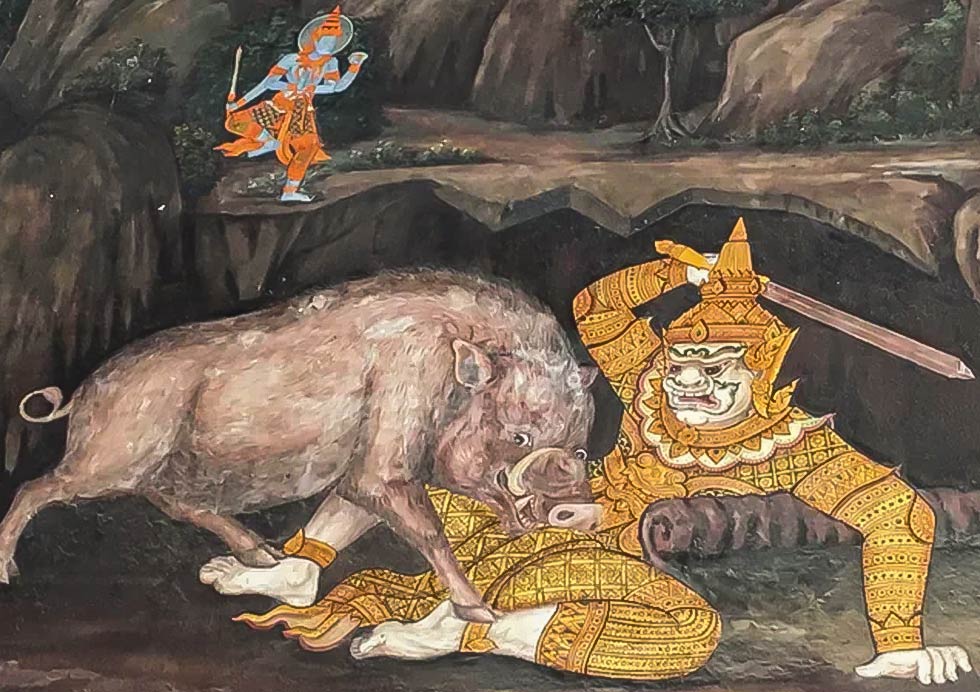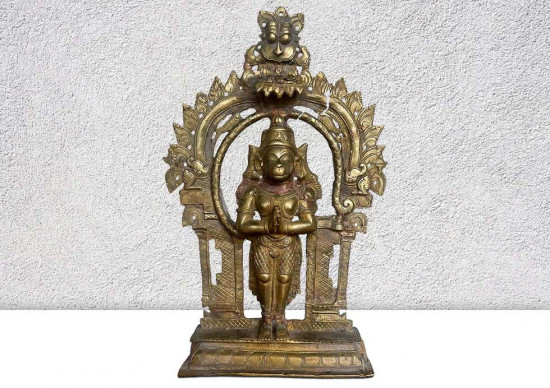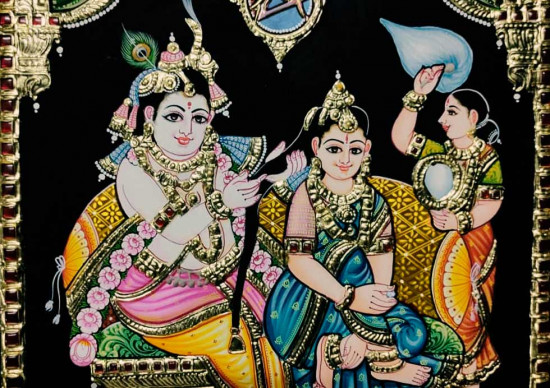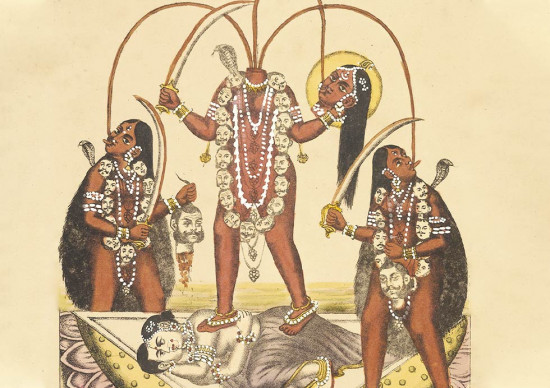
The Varaha Avatar is one of the most intriguing and revered forms of Lord Vishnu. An incarnation that showcases the deity’s boundless compassion and omnipotence. Part of the famous Dashavatara of Vishnu, the Varaha Avatar is the third incarnation in the series, following the Matsya Avatar (the fish) and preceding the Narasimha Avatar (the man-lion). The story of Varaha Avatar tells of Vishnu’s divine intervention to rescue the Earth (Bhumi) from the clutches of the demon Hiranyaksha, and it is a tale of cosmic struggle, divine strength, and ultimate restoration of order in the universe.

The Cosmic Balance: The Earth in Peril
In Hindu literature, the Earth (known as Bhumi Devi) is often personified as a goddess, revered as the mother of all beings. She is a vital part of the universe’s ecosystem, symbolizing fertility, stability, and the nurturing aspect of nature. However, during a period when the forces of chaos were on the rise, the Bhumi devi found herself in grave peril. The demon Hiranyaksha, whose power was immense and ever-growing, decided to take control of Bhumi. Desiring to dominate the entire cosmos, he dragged the Bhu devi to the depths of the primordial ocean, submerging it and plunging the world into darkness and despair.

This catastrophic event disrupted the natural order, leaving the heavens in turmoil. The gods, unable to restore the Bhu devi to its rightful place, turned to Lord Vishnu, the protector and preserver of the universe. In his infinite wisdom and boundless compassion, Sri Vishnu understood that only a divine intervention could save Bhumi from the demon’s tyranny.
The Story of Varaha

The story of Varaha, the boar incarnation of Vishnu, is a crucial episode in Hindu literature, particularly described in the Puranas. Varaha, the third avatar of Vishnu, is depicted as a wild boar that rescues Bhumi devi, personified as Bhumi, from the demon Hiranyaksha, who had submerged it in the cosmic ocean.
Hiranyaksha was the son of the sage Kashyapa and the asura Diti. Having performed severe austerities to Brahma, he obtained a boon that made him invulnerable to death at the hands of gods, men, or beasts. With this boon, Hiranyaksha became a powerful force, and in his arrogance, he pulled Bhudevi deep into the cosmic waters, taking her to the underworld (Patala), thereby disrupting the natural balance.
The gods, including Indra and Brahma, called upon Sri Vishnu to save Bhumi and defeat the demon. To save Bhumi devi, Kord Vishnu manifested as Varaha, a boar with immense strength and power. In this form, Sri Vishnu descended into the cosmic ocean, where a fierce battle ensued between him and Hiranyaksha. Hiranyaksha, full of arrogance, tried to stop Lord Vishnu, but Varaha overpowered him. Ultimately, Vishnu slayed Hiranyaksha with his tusks, rescuing the Earth and placing it back in its rightful position in the cosmos.
Hiranyaksha had an elder brother, Hiranyakashipu, who also received a boon of invulnerability, which led him to conquer the three worlds. Hiranyakashipu, angry at his brother’s death, sought to avenge him and torment his son, Prahlada, a devoted worshiper of Sri Vishnu. Hiranyakashipu was eventually killed by Lord Vishnu in his avatar as Narasimha (the man-lion). Their sister, Holika, also faced divine retribution when she tried to kill her nephew, Prahlada, by burning him alive, but she perished instead.
The boar form of Sri Vishnu is not a later creation but has its roots in the Vedic texts, such as the Rigveda and Taittiriya Samhita. In early Vedic thought, a boar is connected to the creation myth. The boar form is associated with Prajapati, a creator deity, who is said to have assumed the shape of a boar to lift the Earth from the cosmic waters. Over time, the boar became an avatar of Lord Vishnu, symbolizing his cosmic role in both creation and preservation.
The Varaha Avatar not only represents the physical rescue of Earth but also has deeper symbolic meanings. In the Brahmanda Purana, Varaha is described as possessing cosmic significance. His tusks are linked to the Vedas and sacrificial rites, while his other features represent various aspects of the yajna (sacrifice) process. The narrative connects Varaha with themes of cosmic order, sacrifice, and the restoration of balance in the universe.
In the battle between Varaha and Hiranyaksha, Varaha proves his superiority not just through physical might but also through the divine power of Sri Vishnu. The war is depicted in many texts, including the Lord Vishnu Purana, Padma Purana, and Agni Purana. Hiranyaksha, in his attempts to challenge Varaha, even mocks the boar form, but eventually, Varaha triumphs. After the battle, Sri Vishnu, in his boar form, lifts the Earth and restores it to its rightful place, once again stabilizing the universe.
The Varaha Avatar is a tale of divine intervention, where Sri Vishnu takes the form of a boar to restore balance in the world. His battle with Hiranyaksha represents the eternal struggle between good and evil, with Lord Vishnu emerging victorious in his boar incarnation. Varaha not only rescues the Earth but also embodies the symbolic restoration of cosmic order, demonstrating the protective and sustaining nature of Sri Vishnu in the face of demonic forces.
Hiranyaksha was the son of the sage Kashyapa and the asura Diti. Having performed severe austerities to Brahma, he obtained a boon that made him invulnerable to death at the hands of gods, men, or beasts. With this boon, Hiranyaksha became a powerful force, and in his arrogance, he pulled Bhudevi deep into the cosmic waters, taking her to the underworld (Patala), thereby disrupting the natural balance.
The gods, including Indra and Brahma, called upon Sri Vishnu to save Bhumi and defeat the demon. To save Bhumi devi, Kord Vishnu manifested as Varaha, a boar with immense strength and power. In this form, Sri Vishnu descended into the cosmic ocean, where a fierce battle ensued between him and Hiranyaksha. Hiranyaksha, full of arrogance, tried to stop Lord Vishnu, but Varaha overpowered him. Ultimately, Vishnu slayed Hiranyaksha with his tusks, rescuing the Earth and placing it back in its rightful position in the cosmos.
Hiranyaksha had an elder brother, Hiranyakashipu, who also received a boon of invulnerability, which led him to conquer the three worlds. Hiranyakashipu, angry at his brother’s death, sought to avenge him and torment his son, Prahlada, a devoted worshiper of Sri Vishnu. Hiranyakashipu was eventually killed by Lord Vishnu in his avatar as Narasimha (the man-lion). Their sister, Holika, also faced divine retribution when she tried to kill her nephew, Prahlada, by burning him alive, but she perished instead.
The boar form of Sri Vishnu is not a later creation but has its roots in the Vedic texts, such as the Rigveda and Taittiriya Samhita. In early Vedic thought, a boar is connected to the creation myth. The boar form is associated with Prajapati, a creator deity, who is said to have assumed the shape of a boar to lift the Earth from the cosmic waters. Over time, the boar became an avatar of Lord Vishnu, symbolizing his cosmic role in both creation and preservation.
The Varaha Avatar not only represents the physical rescue of Earth but also has deeper symbolic meanings. In the Brahmanda Purana, Varaha is described as possessing cosmic significance. His tusks are linked to the Vedas and sacrificial rites, while his other features represent various aspects of the yajna (sacrifice) process. The narrative connects Varaha with themes of cosmic order, sacrifice, and the restoration of balance in the universe.
In the battle between Varaha and Hiranyaksha, Varaha proves his superiority not just through physical might but also through the divine power of Sri Vishnu. The war is depicted in many texts, including the Lord Vishnu Purana, Padma Purana, and Agni Purana. Hiranyaksha, in his attempts to challenge Varaha, even mocks the boar form, but eventually, Varaha triumphs. After the battle, Sri Vishnu, in his boar form, lifts the Earth and restores it to its rightful place, once again stabilizing the universe.
The Varaha Avatar is a tale of divine intervention, where Sri Vishnu takes the form of a boar to restore balance in the world. His battle with Hiranyaksha represents the eternal struggle between good and evil, with Lord Vishnu emerging victorious in his boar incarnation. Varaha not only rescues the Earth but also embodies the symbolic restoration of cosmic order, demonstrating the protective and sustaining nature of Sri Vishnu in the face of demonic forces.
Bhumi's Gratitude and the Significance of the Varaha Avatar
Once the Bhuni devi was returned to its rightful place, Bhumi Devi, the personification of the Earth, expressed her immense gratitude to Vishnu for saving her from the demon’s clutches. In her appreciation, Bhumi offered Vishnu praises, acknowledging his selfless act of protection. The tale of Vishnu’s Varaha Avatar is not just about defeating a demon; it also emphasizes the importance of devotion, faith, and divine grace in restoring balance to the world.
The Varaha Avatar also holds great significance in the broader context of Vishnu’s Dashavatara. Each incarnation of Vishnu is an expression of his divine role as the protector of the universe, and each avatar serves a unique purpose. The Varaha Avatar, with its emphasis on the physical restoration of the Earth, highlights Vishnu’s role in both preserving the natural world and ensuring that cosmic balance is never lost, even in times of extreme adversity.
The Varaha Avatar also holds great significance in the broader context of Vishnu’s Dashavatara. Each incarnation of Vishnu is an expression of his divine role as the protector of the universe, and each avatar serves a unique purpose. The Varaha Avatar, with its emphasis on the physical restoration of the Earth, highlights Vishnu’s role in both preserving the natural world and ensuring that cosmic balance is never lost, even in times of extreme adversity.
The Iconography of Vishnu’s third avatar, Varaha
The iconography of Vishnu’s third avatar, Varaha, is both rich and vibrant, reflecting the diverse traditions and stories surrounding him. Varaha is often depicted in two primary forms: as a wild boar (zoomorphic) or as a blend of human and boar (anthropomorphic). In the zoomorphic form, Varaha is shown as a mighty boar who courageously rescues the Earth from the cosmic ocean, where it had been submerged by the demon Hiranyaksha. This portrayal highlights his role as a fierce protector, carrying the Earth on his tusks to restore balance. In contrast, the anthropomorphic form depicts Varaha with a human body and the head of a boar. This unique depiction blends human strength and animal instinct, much like Vishnu’s other avatar, Narasimha, who combines the form of a lion and man. Unlike earlier avatars like Matsya (the fish) and Kurma (the turtle), which have only partial animal features, Varaha is one of the first to maintain a fully human torso with a boar’s head, making him especially distinctive.
Varaha is often shown in a powerful, combative stance called alidha, with one leg straight and the other bent. His presence is deeply rooted in cosmic symbolism, as he is frequently depicted standing on the serpent Shesha, which represents the stability of the universe. With one foot placed on Shesha’s hood and his other foot on a turtle, he embodies the balance of all elements in creation. In his four hands, Varaha holds objects filled with meaning: a mace (gada) to symbolize strength, a conch (shankha) representing the eternal sound of the cosmos, a discus (chakra) to vanquish evil, and a lotus (padma), which reflects purity and beauty. Often, Varaha is shown with the Earth goddess, Bhudevi, either resting on his tusks or in his lap, symbolizing his role in protecting and uplifting the Earth, a gesture that connects him deeply to the restoration of cosmic harmony.
In addition to these physical attributes, Varaha’s hand gestures (mudras) further express his divine qualities. The abhayamudra, or gesture of reassurance, is a common feature, representing his promise of safety and protection to his devotees. The varadamudra, a gesture of blessing, signifies his capacity to grant boons and favors to those who seek his grace. Some texts even describe Varaha’s form as golden or resplendent, highlighting his radiant divinity. He is often depicted wearing yellow garments, with the Kaustubha jewel and the Srivatsa symbol adorning his chest, symbols of divine wealth and auspiciousness. Additional weapons like a sword or javelin may also be seen in his hands, emphasizing his warrior-like qualities as he combats evil forces.
At its heart, Varaha’s iconography speaks to his role as a protector, a restorer of balance, and a beacon of cosmic wisdom. His imagery reminds us of the triumph of divine power over adversity, and his presence is closely tied to the preservation of the Earth and all life within it. Varaha is not just a symbol of divine intervention but a reminder of the eternal wisdom, wealth, and protection that sustains our world. Worship of Varaha is often associated with prosperity, spiritual growth, and the restoration of cosmic harmony, making him a beloved deity who brings light and stability to the universe.
Varaha is often shown in a powerful, combative stance called alidha, with one leg straight and the other bent. His presence is deeply rooted in cosmic symbolism, as he is frequently depicted standing on the serpent Shesha, which represents the stability of the universe. With one foot placed on Shesha’s hood and his other foot on a turtle, he embodies the balance of all elements in creation. In his four hands, Varaha holds objects filled with meaning: a mace (gada) to symbolize strength, a conch (shankha) representing the eternal sound of the cosmos, a discus (chakra) to vanquish evil, and a lotus (padma), which reflects purity and beauty. Often, Varaha is shown with the Earth goddess, Bhudevi, either resting on his tusks or in his lap, symbolizing his role in protecting and uplifting the Earth, a gesture that connects him deeply to the restoration of cosmic harmony.
In addition to these physical attributes, Varaha’s hand gestures (mudras) further express his divine qualities. The abhayamudra, or gesture of reassurance, is a common feature, representing his promise of safety and protection to his devotees. The varadamudra, a gesture of blessing, signifies his capacity to grant boons and favors to those who seek his grace. Some texts even describe Varaha’s form as golden or resplendent, highlighting his radiant divinity. He is often depicted wearing yellow garments, with the Kaustubha jewel and the Srivatsa symbol adorning his chest, symbols of divine wealth and auspiciousness. Additional weapons like a sword or javelin may also be seen in his hands, emphasizing his warrior-like qualities as he combats evil forces.
At its heart, Varaha’s iconography speaks to his role as a protector, a restorer of balance, and a beacon of cosmic wisdom. His imagery reminds us of the triumph of divine power over adversity, and his presence is closely tied to the preservation of the Earth and all life within it. Varaha is not just a symbol of divine intervention but a reminder of the eternal wisdom, wealth, and protection that sustains our world. Worship of Varaha is often associated with prosperity, spiritual growth, and the restoration of cosmic harmony, making him a beloved deity who brings light and stability to the universe.
Conclusion:
The Varaha Avatar of Lord Vishnu stands as a powerful symbol of divine intervention, cosmic balance, and the triumph of good over evil. Through his incarnation as a boar, Vishnu not only rescues the Earth from the demon Hiranyaksha but also reaffirms the eternal principle that the divine will always restore order when chaos threatens the harmony of the universe. The Varaha Avatar teaches us that no force of evil can ever triumph over the protective and sustaining power of the divine.
As we reflect on the Varaha Avatar and its deeper spiritual significance, it also becomes a source of artistic inspiration. The vivid imagery and symbolism of Varaha have long been celebrated in various forms of art, capturing the essence of this powerful incarnation. Whether through statues, paintings, or other artistic representations, these depictions serve as a reminder of Vishnu’s protective nature and the eternal struggle for cosmic balance. For those interested in exploring this divine form through art, there are many beautiful representations of Varaha that can connect us further to the sacred story.
As we reflect on the Varaha Avatar and its deeper spiritual significance, it also becomes a source of artistic inspiration. The vivid imagery and symbolism of Varaha have long been celebrated in various forms of art, capturing the essence of this powerful incarnation. Whether through statues, paintings, or other artistic representations, these depictions serve as a reminder of Vishnu’s protective nature and the eternal struggle for cosmic balance. For those interested in exploring this divine form through art, there are many beautiful representations of Varaha that can connect us further to the sacred story.









